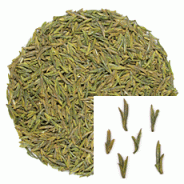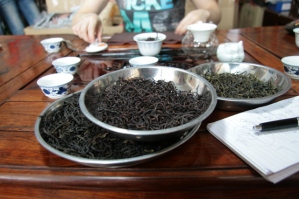With the rush of new spring 2017 tea just a few short weeks away it’s a good time to discuss something which I think speaks to many tea enthusiasts – how to get the best tea for your money from a a crowded marketplace of variously priced teas that appear to be the ‘same’ thing.
Tea producers have an equally daunting task of pricing each and every production run of tea, and in the case of Chinese green tea, for instance, an excess of warm weather can increase the speed with which tea leaf grows in the first few weeks of the harvest. When the weather fails to cooperate, the amount of time for plucking tender bud-only teas may quickly vanish, even before enough of these teas are made.
When this happens tea producers will switch to plucking the next leaf configuration known as a mao feng ( two leaves and a bud) and make tea with it. So the tea in the baskets at the end of the day in the tea factory may be a different pluck from what they had in mind at the beginning of the day. For all tea, the quantity produced as well as the quality of each batch will factor into the price of those batches of tea. So the price of the bud-only tea will reflect a shortage of that tea for the year.
 And so it goes – adjustments to the plucking style are made each and every day as the leaf grows larger. This gives tea producers many choice teas with both small and large grades of differences to sell. Each small batch will most likely have a different price, too.
And so it goes – adjustments to the plucking style are made each and every day as the leaf grows larger. This gives tea producers many choice teas with both small and large grades of differences to sell. Each small batch will most likely have a different price, too.
Tea merchants, on the other hand, have the equally daunting task of finding the right grades of tea to satisfy their customers. The retail cost of any tea is directly related to what the tea merchant paid for the tea, plus a small amount added in to cover freight costs. Tea merchants purchase their teas from a variety of trusted sources – some purchase directly from origin, others from tea importers of varying sizes (in the US) and others from wholesalers (in the US) who purchase teas from larger tea importers. This range of sourcing options can present tea merchants with a dizzying choice of tea in many grades and prices.
So what savvy tea enthusiasts need to realize is this: all tea is not created equally, even when it has the ‘same’ name. Nor is all tea sold equally fresh and sound or from the same plucking season or year.While this may be quite obvious to some, we know from experience that there are plenty of tea drinkers out there who don’t see the correlation between grade and price, and erroneously believe that all tea with the same name is the ‘same’ tea.
Some tea merchants sell consistently high quality tea and others do not – it all depends on their attitude about tea and the teas they select. If you only frequent shops that sell low-priced tea and shun those you fear are over-priced, you may be cheating yourself out of drinking really good tea. Low priced tea will never be good value in the long run.
There is frequent complaining in the tea-o-sphere about the price of tea. Of course, those who are complaining about price usually believe that all prices are too high and that every tea vendor is an evil devil who is out to flinch their tea customers. Honestly, while there is some pretty bad tea being bandied about the internet (and that is something to complain about at any price) and a few merchants who mark their tea up to atmospheric levels, the market is self-policing.
So those serious about staying in business know that today’s transparency on the internet will cast them in a poor light. So, overall, I think the problem is not as great as it is made out to be. I sometimes think that posts like the aforementioned are designed simply to attract readership and cause a tempest in the teapot. It’s a known fact that sensational reviews and posts that rant and rave attract more attention than less flammable opinion does. Grousing is in – in fact, it has now become a sport for some!
So rather than have customers fixate on price, we believe that tea enthusiasts should think more about how to get the best tea that their money can buy. Which is not the same as searching for the lowest price. As shoppers, we need to think more like investors, and expect for ROI – return on investment on our purchases.
 What is ROI on tea? Imagine that you purchased 4 packages of Keemun Congou tea from 4 different tea vendors. You steep each tea fairly and uniformly with the same steeping parameters, and rate the teas on the following points. The level of enjoyment and satisfaction that you received from each tea in relationship to the price is the ROI value. The level of enjoyment and satisfaction is a measure of:
What is ROI on tea? Imagine that you purchased 4 packages of Keemun Congou tea from 4 different tea vendors. You steep each tea fairly and uniformly with the same steeping parameters, and rate the teas on the following points. The level of enjoyment and satisfaction that you received from each tea in relationship to the price is the ROI value. The level of enjoyment and satisfaction is a measure of:
- satisfaction with the taste/flavor/aromatics in the cup
- freshness of taste/flavor/aroma
- degree of seasonal flavor characteristics
- sound condition and good appearance of the leaf
- tasty-ness in relation to price
Ideally, you want to find tasty tea at a price you can afford – the teas that give you, well, the best bang for the buck. You might end up deciding you prefer the most expensive tea, or if the most expensive tea is 2 x the cost of another selection but only a little bit better tasting, then the less costly tea may be the best ROI for you.
How to find teas with the best ROI? Our suggestion is to invest a little money in your future tea drinking this spring (when the fresh teas start arriving) and order the ‘same’ tea from several tea vendors. Do this with 3-4 teas and order the ‘same’ teas from at least 4-5 tea merchants. This will cost you a bit of money, but what you discover will be well worth it.
After you conduct your steeping/tasting experiment, you will most likely find that there is a pattern to the quality of tea each tea merchant sells. Tea vendors position themselves quality-wise, so you will find that some tea will be great, and some, just so-so. Reliable tea shops maintain a discernible level of quality because they know what they want in their teas and stay true to these principles.
And this is what tea enthusiasts should look for – a tea shop or online tea vendor that has a well-thought out selection of good, sound tea that turns over seasonally and stays fresh because it sells. Because in truth, great teas do not pop up in unlikely places. Most know that Walmart is not the place to go to purchase handcrafted goods, nor is Whole Foods the right place to purchase distressed food.
The same holds true for tea. The shop that sold you some 2-year old green tea, and some saw-dusty black tea will not be the place to find a mind-blowing Fenghuang dan cong.
OK, so what factors do tea sellers consider (and you should think of these, too) when purchasing tea to sell? The factors that affect grade/price:
- season of the year and time frame within the season for teas made in the same year
- age and condition of the tea (if it is an aged tea)
- the leaf pluck of the tea (bud most expensive; bud and leaf next most costly; bud and two leaves next most costly)
- amount of hand-work involved in shaping and firing the leaf
- condition of the leaf
- quantity of that tea produced
- the taste/flavor and aroma of the tea
Let’s again use Keemun Congou, a popular Chinese black tea, as an example. Most producers of Keemun sell their tea in 3 categories with 3 price points in each category for a total of 9 different grades of quality.
So, at the retail level the grade of Keemun will account for big differences in the price of the tea. The cost may double, triple or quadruple per kilo from common grades to the highest grade of premium Keemun. Keemun Congou has 9 grades for teas – this does not include other Keemun-related tea such as Keemum Mao Feng or Keemun Hong Xiang Luo, which have their own set of grades and price points. And tea workers like to show off their tea making skills by finessing more and more differences from those tiny tea leaves. So it is not uncommon for small batches of special production Keemun to be outside of the normal grading standards.
Tea producers usually assign letters or numbers to their grades such as Grade A or #1 Grade, but sometimes also use terms such as premium grade, superfine grade, Emperor grade, superior grade, etc. While these can be legitimate grades, these terms may also become diluted when they are used indiscriminately by some tea vendors. On the retail level many Keemun Congous are not sold with a known grade. If the specific details about different Keemun Congous are unknown, you should assume that these are most likely very different teas that merit the taste test to ferret out the best ones.
Chinese spring green teas are manufactured in even more grades and price points, adding a greater level of complexity and confusion for consumers. But there are some clues given at will be of some help in evaluating the quality of spring teas, and these are:
- season of the pluck (when plucked)
- where the tea is from (place)
- configuration of the pluck ( bud, mao jian, mao feng, etc)
Each spring, tea from the new harvest year is sold by tea producers in one of 4 categories based on seasonal divisions/pluck time. Sometimes these markers of pluck time are given for certain teas:
- Pre-Qing Ming or Ming Qian tea (plucked before April 5th)
- Before the Rains or Yun Qian tea (plucked before April 20th)
- Spring tea or Gu Yu tea (plucked before May 6th)
- Late Spring or Li Xia tea (plucked before May 21st)
Each seasonal division has several grades of quality, too. The earliest plucked tea within the division and the most perfect leaf will be the most costly. For XiHu Longjing, a very famous and popular tea worldwide, there are four designated places where authentic Longjing (based on tea bush varietal) is grown: Shi Feng, Meijiawu Village, Weng-jia Shan and West Lake Village. Last year, the 8 grades of XiHu Longjing were listed, as well as the occasional special batch and competition-grade teas.
- AAA Jing Pin: 100% bud and 1 leaf
- AA Te Ji: 70% bud and 1 leaf; 30% 1 bud and 2 leaves
- 1 st Grade: 70 % 1 bud and 2 leaves; 30% 1 bud and 1 leaf
- 2nd Grade
- 3rd Grade
- 4th Grade
- 5th Grade
- 6th Grade
Lastly, for an even more complex listing of grading/pricing, consider a very well-known
yan cha or rock oolong tea – Da Hong Pao. Prices for this tea can range wildly, as can its authenticity, proving a thorny issue for tea merchants. This is an example of last year’s production grades and not counting special small batches; traditional charcoal roasting or not; amount of roasting; new or aged tea; blends of Zheng Yan and Ban Yan, etc.:
Zheng Yan – core production zones
- Grade AAA
- Grade AA
- Grade A
- Grade 1
- Grade 2
- Grade 3
Ban Yan – close to original production zones
- Grade AAA
- Grade AA
- Grade A
- Grade 1
- Grade 2
- Grade 3
- Grade 4
- Grade 5
When purchasing yan cha (or dan cong) remember this: the best ones can cost $1,000 a lb or more in China so are never cheap. The highest grades never leave China. The older these teas are or the rarer the tea bush varietal from which they are made the more expensive they will be. And if these teas have been given a traditional charcoal-roast this will add to the cost as well. Much of the ‘Da Hong Pao’ that is sold in the West is actually Shui Xian – know your vendor!
OK, so before you throw up your hands and say ” What’s a tea drinker to do? ” remember, that the best way to find your way to a clearer path of discernment among tea is to do a little homework and taste a lot of teas to develop your palate.
Keep notes in a book or on your smart phone and educate yourself about the teas you are drinking. Because purchasing tea is not as cut and dry as searching for a specific bottle of a favorite wine by a known producer or finding the brand of chocolate that you like, tea enthusiasts have more work to do to find the right tea vendor for their taste preference and pocketbook. However, once you do, the rewards are tremendous and are well worth the effort required to educate your palate for fine tea.
So, with a new tea season coming, it is time to revel in the fresh new teas that will soon be here. Use a little caution and look for ROI in your tea and you will feel that you have spent your money well for tea that is fresh, tasty and makes you feel good when you drink it. That is the best ROI that we can think of!



























